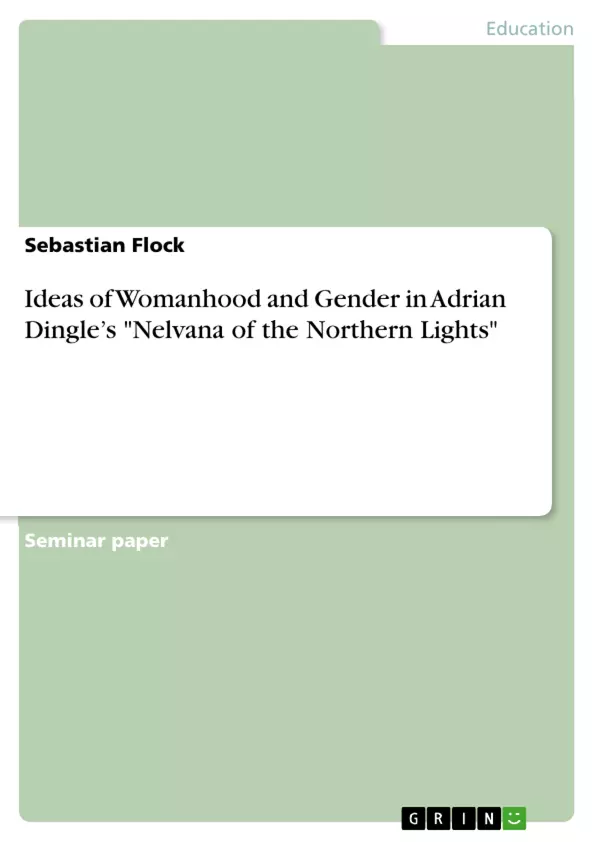The word ‘superheroine’ is often automatically linked to one single woman that is seen as the prototype of this kind of comic book characters - Wonder Woman. Created in 1941 by the American psychologist William Moulton Marston, Wonder Woman has not only become one of the most popular female comic book heroes, she has also been widely considered a feminist icon. Especially the early Wonder Woman comics from 1941 to 1947 are seen as explicitly feminist, going along with the political aims and demands of the women’s liberation
movement in the 60s and 70s. This is due to many recurrent images and themes in Marston’s comic book that crossed socially constructed gender boarders in the 1940s.
But Wonder Woman was not the first female comic hero that appeared in western popular culture. Four months before, a Canadian superheroine with the name Nelvana was introduced to her readership. This creation of the Welsh Canadian painter Adrian Dingle is seen as the first Canadian national superhero, but no research has been done yet about her attitude towards feminist ideals. This is remarkable because Nelvana of the Northern Lights was published at a time when women were still severely suppressed in society. Accordingly, a female superhero was something special that had the potential to derange the socially constructed gender boarders of this point in time, just like Wonder Woman did.
This term paper is supposed to shed some light on this topic. For this purpose, two aspects of Nelvana of the Northern Lights will be examined for potential transgressions of socially constructed gender roles. The focus on her superpowers and her weaknesses allows a closer investigation of her super hero personality and the character itself, the analysis of
Nelvana’s depiction in the context of World War II is useful to survey her attitudes in relation to the Canadian wartime society. Furthermore, both elements are suited for comparisons with Wonder Woman comics because they play an important role in Marston’s stories as well.
Inhaltsverzeichnis (Table of Contents)
- Introduction
- Powers and Weaknesses
- Nelvana's Superpowers
- Nelvana's Weaknesses
- Superheroines in World War II
- Nelvana as a Subordinated Heroine
- Nelvana as an Emancipated Heroine
- Conclusion
Zielsetzung und Themenschwerpunkte (Objectives and Key Themes)
This term paper aims to examine the depiction of womanhood and gender in Adrian Dingle's Nelvana of the Northern Lights by analyzing Nelvana's superpowers, her weaknesses, and her role in the context of World War II. The paper also seeks to compare these aspects with the portrayal of Wonder Woman in early comic books.
- The depiction of female empowerment and its potential for challenging traditional gender roles.
- The influence of societal expectations and power structures on the portrayal of female characters.
- The impact of World War II on the representation of women in popular culture.
- The comparison of Nelvana's characterization with Wonder Woman as a feminist icon.
- The analysis of Nelvana's origin story and its implications for female empowerment.
Zusammenfassung der Kapitel (Chapter Summaries)
- Introduction: This chapter introduces the concept of superheroines and their potential for representing feminist ideals, using Wonder Woman as an example. It then introduces Nelvana of the Northern Lights as the first Canadian superheroine and highlights the significance of analyzing her portrayal in relation to the societal context of her time.
- Powers and Weaknesses: This chapter examines Nelvana's superpowers and her weaknesses in order to analyze the representation of womanhood in the comic. The chapter contrasts Nelvana's inherent powers with Wonder Woman's acquired skills and discusses the implications of this difference for feminist messages.
- Superheroines in World War II: This chapter delves into Nelvana's role in World War II and examines her portrayal in the context of Canadian wartime society. The chapter explores how Nelvana's actions and relationships align with or deviate from prevailing gender roles and norms.
Schlüsselwörter (Keywords)
This paper focuses on key concepts such as superheroines, womanhood, gender roles, feminist ideals, World War II, Canadian popular culture, and the comparison between Nelvana and Wonder Woman. The analysis examines the origins and implications of female superpowers, the impact of societal structures on female characters, and the significance of superheroines as potential feminist icons.
- Arbeit zitieren
- Sebastian Flock (Autor:in), 2016, Ideas of Womanhood and Gender in Adrian Dingle’s "Nelvana of the Northern Lights", München, GRIN Verlag, https://www.hausarbeiten.de/document/346929


